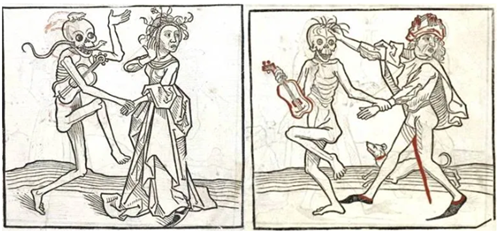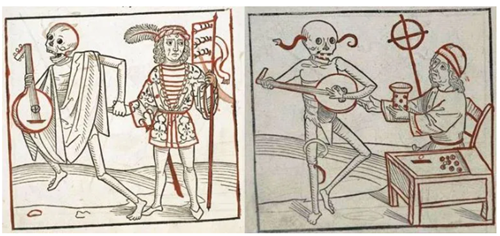

The history of the acoustic guitar stretches back further than you might think. We look at the story of this iconic instrument, which has undergone various transformations through the years…
Ancient beginnings
The acoustic guitar can be traced back to the Uruk period between 3500BC and 3200BC and an engraving on a small round cylinder.
The engraving, from the region of Mesopotamia in Iraq, depicts a woman playing the oud – a fretless, short-neck, plucked lute which was popular in Arabic culture at the time.
This engraving has since been acquired by Dr. Dominique Collon and is housed at the British Museum in London.
The Ancient Egyptians, Greeks and Persians were among the chief pioneers of stringed instruments. In fact, the oldest surviving guitar-like instrument is a tanbur from Egypt, dating back to circa 1500 BC. This instrument is a fretted lute with three strings, a long neck and a pear-shaped sound box.
It was owned by a court singer by the name of Har-Mose, who sang for the Egyptian queen Hatshepsut. You can see the sacred ancient artefact for yourself at the Archaeological Museum in Cairo.
Ancient Greece and the Roman Empire
By around 700 BC, the kithara had become prominent in ancient Greece. This instrument sounds familiar, doesn’t it? Well, that’s because it is.
The word ‘guitar’ is believed to originate from the ancient Greek word ‘kithara’ and this instrument shares much of its successor’s characteristics.
An instrument of the lyre family, the kithara was made up of seven strings of equal length and a wooden body, usually with a flat base. It had a wooden soundboard and its body was made of two tables connected by ribs.
To play this instrument, a kithara player would hold it upright, typically stroking the “plektron” (pick) across the strings using their right hand and muting the silent strings with their left hand.
The kithara was typically played by professional musicians and became a staple of Greek public performances by the end of the 7th century BC. It would also play a crucial role in the creation of the lute (more on that later).
Sometime around 40 AD, the Romans entered Spain (or Hispania as it was known back then) – and brought the kithara with them. Henceforth, the kithara became synonymous with Western European culture.
The Middle Ages
This was another key period in the development of the modern-day acoustic guitar – and once again, Spain was at the centre of this development.
The Moors, a nomadic people from North Africa, invaded Spain in 711 AD (which marked the start of the Moorish Invasion). They brought their ouds with them and as a result, a crucial breakthrough was made.
The Europeans combined the characteristics of the oud and cithara, adding frets to the oud and calling it a “lute”. This is simply an amalgamation of the Arabic word “Al’ud” (literally “the wood”) and the Spanish name “laud”.
With this development, the fretboard – a key feature of the modern-day acoustic guitar – was born.
The Moorish oud and European lute had striking similarities to the modern-day acoustic guitar:
- Both are stringed instruments which need to be plucked or strummed by hand to create a sound.
- Both include a hollow box which helps produce and amplify said sound.
The lute grew in popularity throughout the Middle Ages. A few centuries later, it would inspire the vihuela – an instrument which played a peripheral role in the development of the acoustic guitar.
The Renaissance period
A notable date of the Renaissance period in the acoustic guitar’s development is 1488, when the Heidelberger Totentanz was published. This German book contains 38 prints by an unknown author, each of which depict the figure of death holding stringed instruments of the time. These include the lute, vielle and renaissance guitar.


Two renaissance guitars feature in the second set of illustrations, which confirm the instrument’s existence in 1488. It wouldn’t properly emerge until the 16th century, however.
Around this time, a fretted and plucked Spanish string instrument containing five or six doubled strings was starting to come to the fore. This instrument was called the vihuela – or vihuela de mano – which was essentially a flat-backed version of the lute.
It first rose to prominence in the Kingdom of Aragon, north-eastern Iberia, and was played primarily by the aristocracy. Like a large guitar, it had six or seven double courses of strings. It was tuned like the lute – G–C–F–A–D–G – and was the earliest string instrument relating directly to the modern acoustic guitar.
The vihuela came in three forms:
- Vihuela de mano: 5 or 6 courses played with the fingers
- Vihuela de penola: Played with a plectrum
- Vihuela de arco: Played with a bow (ancestor of the viola da gamba)
The vihuela was commonly played in Spain, Portugal and Italy and reached the peak of its popularity in the mid to late 16th century. By the late 16th century, though, its usage has declined. However, it would evolve into the baroque guitar – and the classical guitar shortly after.
The Classical period
Arguably the most poignant period of musical history, the Classical period was a golden age for the guitar.
During the Baroque period from 1600 and 1750, 5-course guitars were the norm. However, come the late 18th century, these were abandoned in favour of 6-course guitars (soon, these too would be abandoned, in favour of their 6-string counterparts).
Between 1730 and 1820, a new generation of guitar composers and performers became stars of the time – most notably in Spain. Dionisio Aguado y García and Fernando Sor were among the foremost guitarists of the Classical period and the pair were close friends.
Aguado popularised the use of fingernails when playing the guitar and invented the tripodison, an accessory used to hold the guitar instead of letting it rest on the leg.
Sor was known for his unorthodox playing style – unlike his peers, he rarely used the ring finger of his plucking hand. Instead, he opted to use the thumb, index, and middle fingers of his right hand. Sor also composed numerous arrangements for the opera, orchestra and ballet – including Introduction and Variations on a Theme by Mozart.
Sor, who is widely regarded as the best guitarist of the Classical period, passed away in 1839. Little over 10 years after his passing, a key breakthrough was made.
The Romantic period
Around 1850, a Spanish guitar maker called Antonio Torres Jurado began to transform the guitar’s structure. He owned a guitar shop in Seville, where he constructed his own guitars. From here, he made several crucial alterations.
Firstly, he increased the size of the guitar’s body to increase its volume. He also fitted it with lighter, thinner and larger soundboards which were arched in both directions.
Arguably the most important alteration Torres made to the acoustic guitar was the invention of the fan-braced pattern. This is the series of wooden struts needed to reinforce the soundboard, support the tension of the strings and prevent the instrument from collapsing under tension. They’re also an important factor in how a guitar sounds.
Torres produced a series of guitars from his Seville workshops, some of which were played by such renowned musicians as Francisco Tárrega and Miguel Llobet.
Due to his innovation and enterprise, Torres is considered the most important inventor in the history of the acoustic guitar.
Another key guitar innovator from the Romantic period is Christian Frederick Martin. He is best known for establishing the C. F. Martin & Company, a leading guitar manufacturing company from New York which is still in operation six generations later.
Martin, a German-born American, established C.F. Martin & Company in 1833. Around a decade later, between 1842 and 1843, he created what is believed to be the world’s first X-braced guitar (a video visualising Martin’s revolutionary X-bracing method is below).
This bracing method would help withstand the tension created by steel strings, which eventually became a prominent feature of the acoustic guitar in the early 20th century.
The early to mid-20th century
In 1902, American luthier Orville H. Gibson founded a company in Kalamazoo, Michigan. This company is known today as Gibson Brands Inc. and is one of the world’s most famous acoustic guitar manufacturers.
Gibson is credited with creating the archtop guitar, which redefined volume, tone and vibration. The archtop guitar had violin-like sound holes, an adjustable bridge and a curved body. These features enabled it to vibrate freely and produce a louder sound. It’s little surprise, therefore, that it was later adopted by jazz, country and swing musicians.
By the early 1920’s, C.F. Martin & Company had begun focusing its production on steel string guitars. These produced crisper and clearer sounds, while also enabling banjo players playing the then-popular style of country music to switch over without discomfort. The X-brace subsequently became the industry standard for the steel string acoustic guitar (for the reason given above).
Later that decade, in 1927, John Dopyera invented the resonator guitar. This was designed to project enough volume to play alongside banjos and other instruments in the rhythm section. This was then adapted and recreated through The Selmer Guitar, a French instrument developed by Selmer-Maccaferri in the early 1930s.
These developments went a long way towards improve the acoustic guitar’s loudness issues in live performance- as did the invention of the electro-acoustic guitar. Electric guitars began to take off in the 1950’s and during this decade, the Gibson J-160E was invented.
The 1960s and beyond
Believed to be one of the world’s first electro-acoustic guitars, the Gibson J-160E became one of the faces of 1960’s rock n’ roll.
It was made famous by the Beatles’ television appearances and is the only guitar to feature on every one of the Fab Four’s albums. Here it is in action in the music video for ‘This Boy’…
Between the 1960’s and 1980’s, acoustic guitar amplification reached unprecedented levels thanks to advances in design and technology.
At the start of this period, many artists simply pointed a microphone between the guitar’s neck and body for live performances. However, this often resulted in feedback issues and problems picking up sound.
To counteract this, guitar manufacturer Oviation created a ‘parabolic’ or ’rounded’ back made from a glass fibre-like material in the 1960’s. This greatly reduced feedback, enabling greater amplification of the acoustic guitar.
Oviation was once again at the centre of innovation in the 1970’s, when it developed thinner soundboards to further increase the acoustic guitar’s volume and reduce feedback when it was mic’d up. The company also put a piezoelectric pickup in the guitar’s saddle to increase sound quality.
Over in Japan, Takamine made major strides during the 1980s. The company pioneered the use of an active acoustic pickup, which featured an onboard preamp and sliding EQ controls. It also created both passive and active acoustic guitar pickups which could be tailored to different instruments and applications.
The world of acoustic guitar amplification continues to excel today, as companies like LR Baggs, Fishman, and DiMarzio continue to bring innovative technology to the market. Check out this demo of the L.R. Baggs Anthem Acoustic Guitar Pickup to see this technology for yourself…
